Abstract
In the semisynthetic compound phorbol 12-retinoate 13-acetate (PRA), the antipromoting principle of vitamin A acid is combined with the structure of a phorbol ester tumor promoter. In skin of NMRI mice, a single topical application of PRA induces skin inflammation, epidermal proliferation, and sustained hyperplasia to a similar extent and apparently along the same pathway as an equimolar dose of the strong tumor promoter phorbol 12-myristate 13-acetate (PMA). The mitogenic effects of both PRA and PMA are mediated by prostaglandin E synthesis. However, in mouse skin initiated with 7,12-dimethylbenz[a]anthracene, PRA does not promote tumor development, even at a high dose. Under continuous PRA treatment, however, one to four applications of PMA (insufficient by itself to promote tumor growth) gave a strong tumor response. Thus, it can be demonstrated that the effects necessary for tumor promotion can be brought about by a single application of PMA and that the subsequent chronic hyperproliferation of epidermis is probably necessary only to make the tumors visible. By using the nonpromoting irritant mitogen PRA, the concept of two-stage tumor promotion can thus be strongly supported. Furthermore, in the NMRI mouse, PRA is a much more potent second-stage promoter than mezerein, recently reported to be an incomplete promoter in the Sencar mouse.
Full text
PDF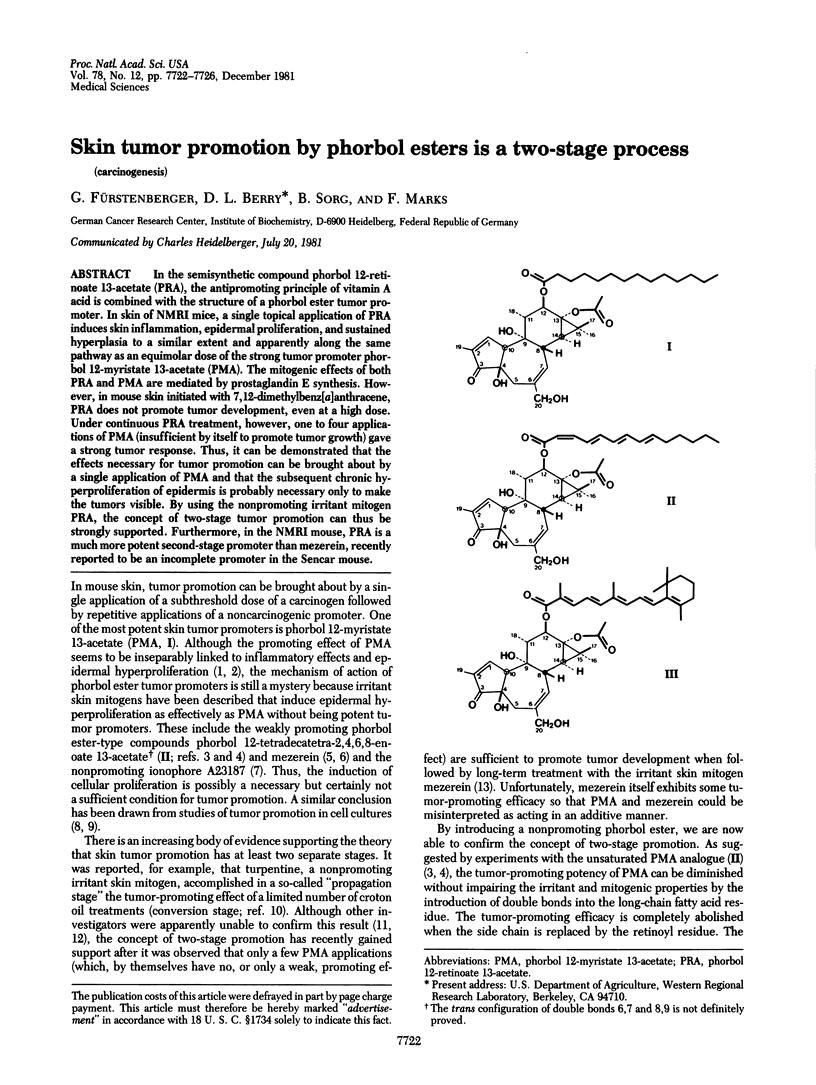
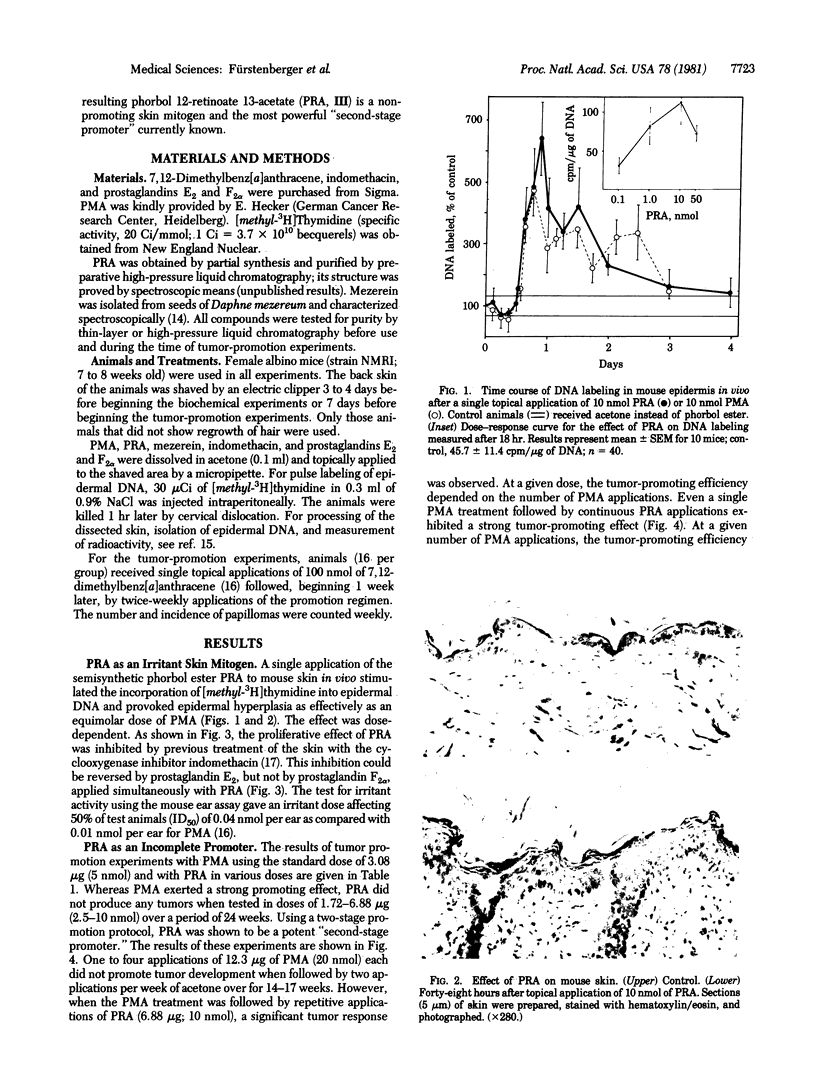
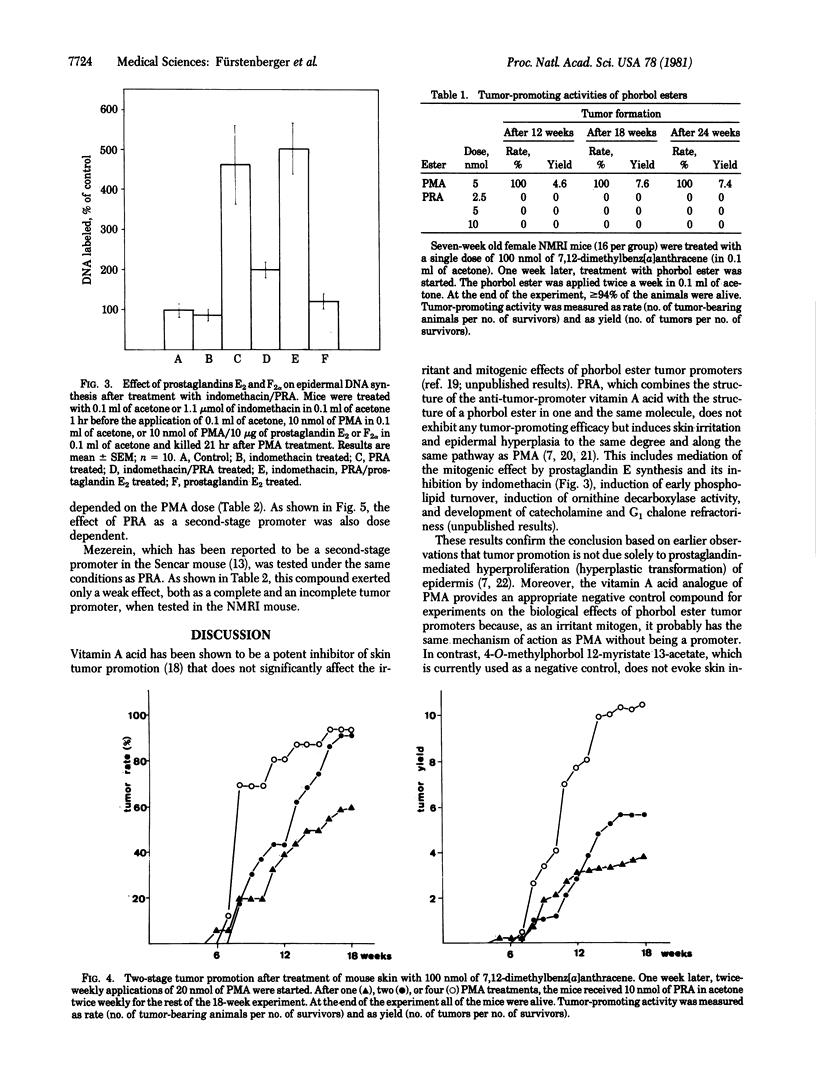
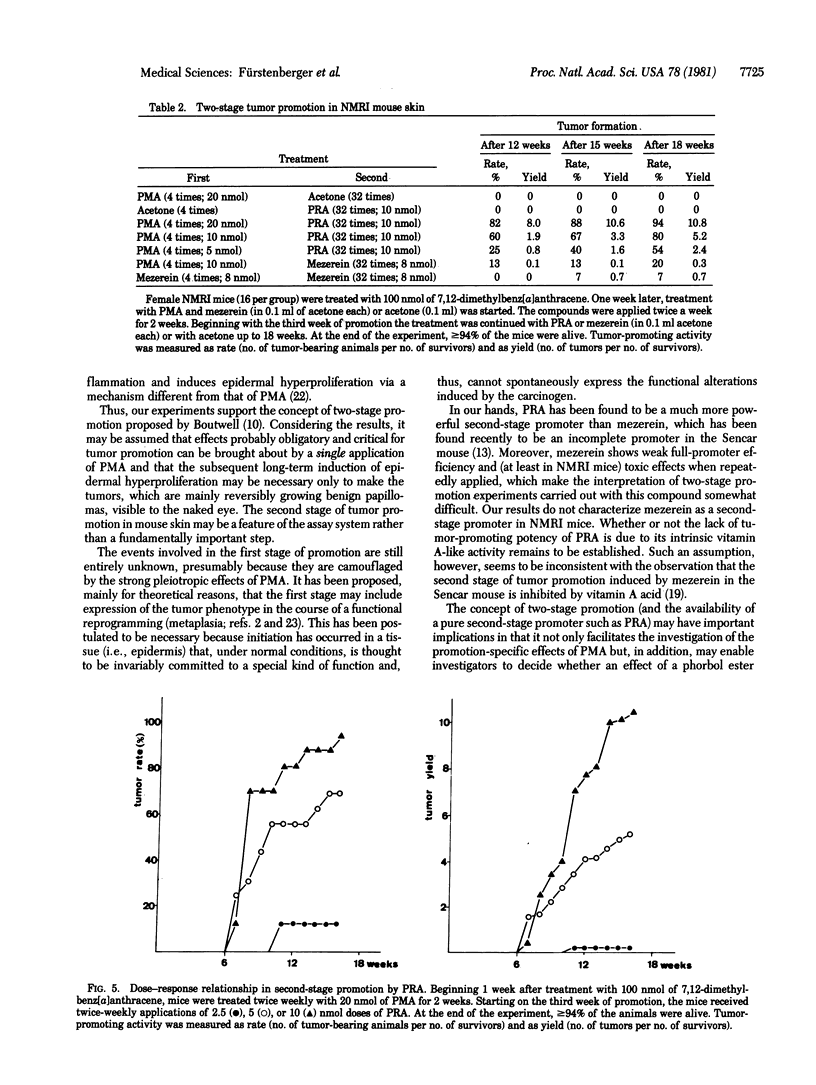
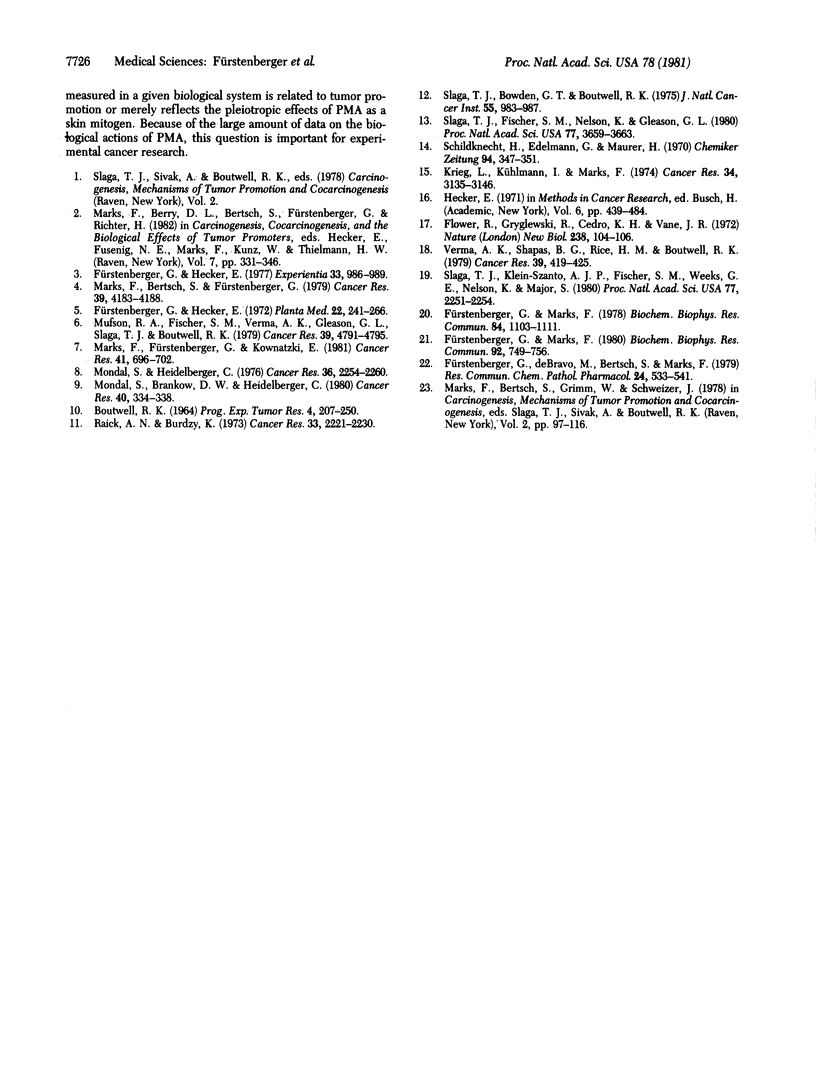
Images in this article
Selected References
These references are in PubMed. This may not be the complete list of references from this article.
- BOUTWELL R. K. SOME BIOLOGICAL ASPECTS OF SKIN CARCINOGENISIS. Prog Exp Tumor Res. 1964;4:207–250. doi: 10.1159/000385978. [DOI] [PubMed] [Google Scholar]
- Flower R., Gryglewski R., Herbaczyńska-Cedro K., Vane J. R. Effects of anti-inflammatory drugs on prostaglandin biosynthesis. Nat New Biol. 1972 Jul 26;238(82):104–106. doi: 10.1038/newbio238104a0. [DOI] [PubMed] [Google Scholar]
- Fürstenberger G., Hecker E. New highly irritant euphorbia factors from latex of Euphorbia tirucalli L. Experientia. 1977 Aug 15;33(8):986–988. doi: 10.1007/BF01945920. [DOI] [PubMed] [Google Scholar]
- Fürstenberger G., Hecker E. Zum Wirkungsmechanismus cocarcinogener Pflanzeninhaltsstoffe. Planta Med. 1972 Nov;22(3):241–266. doi: 10.1055/s-0028-1099610. [DOI] [PubMed] [Google Scholar]
- Fürstenberger G., Marks F. Early prostaglandin E synthesis is an obligatory event in the induction of cell proliferation in mouse epidermis in vivo by the phorbol ester TPA. Biochem Biophys Res Commun. 1980 Feb 12;92(3):749–756. doi: 10.1016/0006-291x(80)90767-6. [DOI] [PubMed] [Google Scholar]
- Fürstenberger G., Marks F. Indomethacin inhibition of cell proliferation induced by the phorbolester TPA is reversed by prostaglandin E2 in mouse epidermis in vivo. Biochem Biophys Res Commun. 1978 Oct 30;84(4):1103–1111. doi: 10.1016/0006-291x(78)91697-2. [DOI] [PubMed] [Google Scholar]
- Fürstenberger G., de Bravo M., Bertsch S., Marks F. The effect of indomethacin on cell proliferation induced by chemical and mechanical means in mouse epidermis in vivo. Res Commun Chem Pathol Pharmacol. 1979 Jun;24(3):533–541. [PubMed] [Google Scholar]
- Krieg L., Kühlmann I., Marks F. Effect of tumor-promoting phorbol esters and of acetic acid on mechanisms controlling DNA synthesis and mitosis (Chalones) and on the biosynthesis of histidine-rich protein in mouse epidermis. Cancer Res. 1974 Nov;34(11):3135–3146. [PubMed] [Google Scholar]
- Marks F., Bertsch S., Fürstenberger G. Ornithine decarboxylase activity, cell proliferation, and tumor promotion in mouse epidermis in vivo. Cancer Res. 1979 Oct;39(10):4183–4188. [PubMed] [Google Scholar]
- Marks F., Fürstenberger G., Kownatzki E. Prostaglandin E-mediated mitogenic stimulation of mouse epidermis in vivo by divalent cation ionophore A 23187 and by tumor promoter 12-O-tetradecanoylphorbol-13-acetate. Cancer Res. 1981 Feb;41(2):696–702. [PubMed] [Google Scholar]
- Mondal S., Brankow D. W., Heidelberger C. Two-stage chemical oncogenesis in cultures of C3H/10T1/2 cells. Cancer Res. 1976 Jul;36(7 Pt 1):2254–2260. [PubMed] [Google Scholar]
- Mondal S., Heidelberger C. Inhibition of induced differentiation of C3H/10T 1/2 clone 8 mouse embryo cells by tumor promoters. Cancer Res. 1980 Feb;40(2):334–338. [PubMed] [Google Scholar]
- Mufson R. A., Fischer S. M., Verma A. K., Gleason G. L., Slaga T. J., Boutwell R. K. Effects of 12-O-tetradecanoylphorbol-13-acetate and mezerein on epidermal ornithine decarboxylase activity, isoproterenol-stimulated levels of cyclic adenosine 3':5'-monophosphate, and induction of mouse skin tumors in vivo. Cancer Res. 1979 Dec;39(12):4791–4795. [PubMed] [Google Scholar]
- Raick A. N., Burdzy K. Ultrastructural and biochemical changes induced in mouse epidermis by a hyperplastic agent, ethylphenylpropiolate. Cancer Res. 1973 Oct;33(10):2221–2230. [PubMed] [Google Scholar]
- Slaga T. J., Bowden G. T., Boutwell R. K. Acetic acid, a potent stimulator of mouse epidermal macromolecular synthesis and hyperplasia but with weak tumor-promoting ability. J Natl Cancer Inst. 1975 Oct;55(4):983–987. doi: 10.1093/jnci/55.4.983. [DOI] [PubMed] [Google Scholar]
- Slaga T. J., Fischer S. M., Nelson K., Gleason G. L. Studies on the mechanism of skin tumor promotion: evidence for several stages in promotion. Proc Natl Acad Sci U S A. 1980 Jun;77(6):3659–3663. doi: 10.1073/pnas.77.6.3659. [DOI] [PMC free article] [PubMed] [Google Scholar]
- Slaga T. J., Klein-Szanto A. J., Fischer S. M., Weeks C. E., Nelson K., Major S. Studies on mechanism of action of anti-tumor-promoting agents: their specificity in two-stage promotion. Proc Natl Acad Sci U S A. 1980 Apr;77(4):2251–2254. doi: 10.1073/pnas.77.4.2251. [DOI] [PMC free article] [PubMed] [Google Scholar]
- Verma A. K., Shapas B. G., Rice H. M., Boutwell R. K. Correlation of the inhibition by retinoids of tumor promoter-induced mouse epidermal ornithine decarboxylase activity and of skin tumor promotion. Cancer Res. 1979 Feb;39(2 Pt 1):419–425. [PubMed] [Google Scholar]




